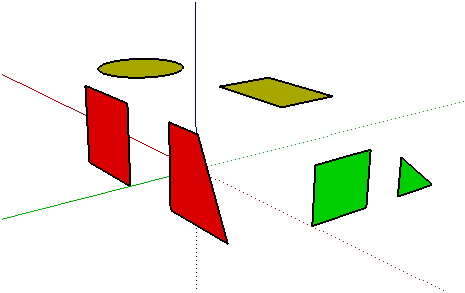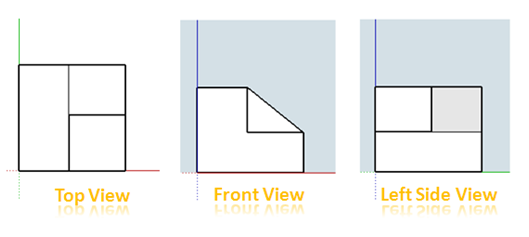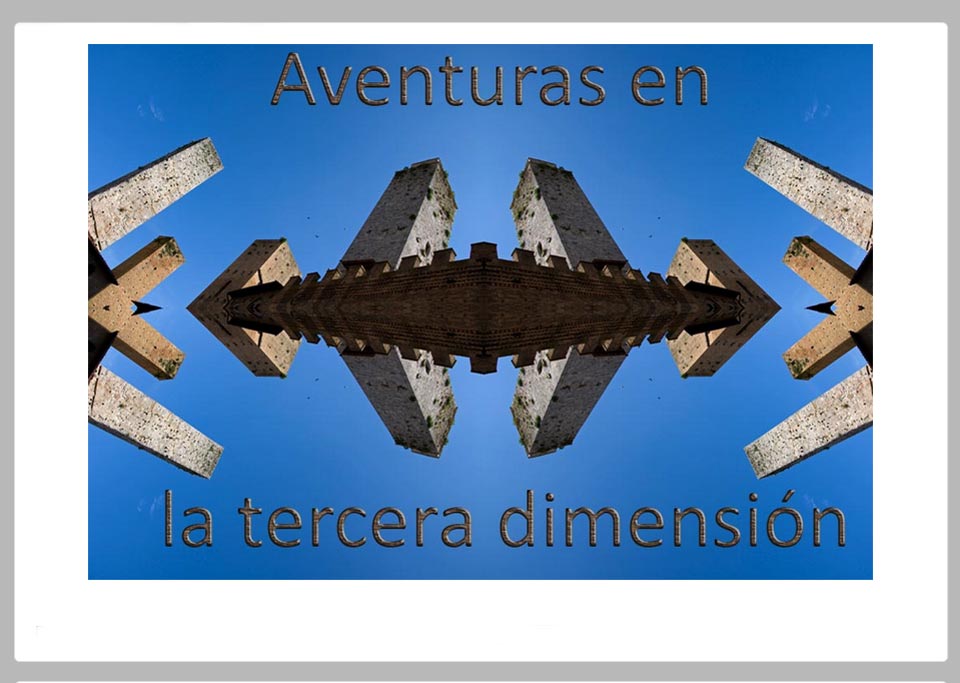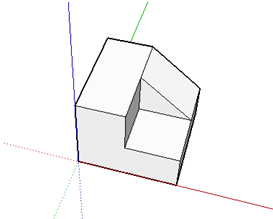enhance geometric drawings as well as how to use it in classroom teaching. In this article, we will discuss more ideas on how to use Google Sketchup inteaching mathematics.
Although Google Sketchup is a drawing software, it can be very helpful tomathematics teachers especially in teaching three dimensional geometry. Using Sketchup, it is easy to demonstrate what do we mean by coplanar or non-coplanar as shown in Figure 1.

Figure 1
Of course, we can do this using a flat surface, say a table, but Google Sketchup is good for reinforcement since it can be manipulated to view surfaces and solids from any direction. This capability enables the user to view the front, back, top, bottom, and side (left or right) of a solid. For instance, the front, side and top views of a the solid shown in Figure 2 is shown in Figure 3.
In addition, it is very easy to construct solids using Google Sketchup. Click the video below to watch how to construct Figure 2.
Several exercises can be done using the solid above.
- Let the students manipulate the solid and draw their nets.
- Let the students get the surface area of the solid.
- Let the students draw the front, side, and top views of the solid.
- Let the students do the reverse of 3 – that is, draw the front, side, and top view, and let the students draw the solid. This is a very good visualization exercise.

Figure 3
If you have drawn a solid, you can get the different 2D views such as Top, Bottom, Front, Back, Left, or Right by selecting the Camera menu from the menu bar and clicking Standard Views.
One reminder though: To get the different two dimensional views of a 3D object, you must switch first to the Parallel Projection mode. To do this, click theCamera menu, and then select Parallel Projection. You can try the Perspective, when 2D viewing and see the difference.
This entry was posted in Google Sketchup, Software Tutorials, Teaching Tools,Web 2.0 Technology and tagged 3d drawing download, 3d drawing program, 3d drawing software, free 3d software, free software, google drawing program,google sketchup 6, google sketchup 7, google sketchup drawing, google sketchup tutorials, isometry geometry, isometry math, isometry transformation. Bookmark the permalink.
Augmented reality
With AR-media™ Plugin, Google™ SketchUp™ users are allowed to visualize their 3D models using Augmented Reality directly in the real physical space which surrounds them. In a very precise sense, through AR-media™ Plugin, SketchUp™ 3D models can be visualized out of the digital workspace directly on users' desktop, by connecting a simple webcam and by printing a suitable code.
By means of the Exporting feature, users can create and publish augmented reality files autonomously. Files created by this feature can be visualized on any computer with the freely available AR-media™ Player, without the need of having Google™ SketchUp™ and the Plugin installed. Users can now create their own SketchUp™ Augmented Reality models and distribute them to their clients as independent, stand-alone files and let their clients experience such models in Augmented Reality in a click.
The AR-media™ Plugin provides users with an advanced visualization functionality which serves two main purposes:
By means of the Exporting feature, users can create and publish augmented reality files autonomously. Files created by this feature can be visualized on any computer with the freely available AR-media™ Player, without the need of having Google™ SketchUp™ and the Plugin installed. Users can now create their own SketchUp™ Augmented Reality models and distribute them to their clients as independent, stand-alone files and let their clients experience such models in Augmented Reality in a click.
The AR-media™ Plugin provides users with an advanced visualization functionality which serves two main purposes:
- Study and analyze scaled virtual prototypes in real environments
- Communicate 3D projects immersively and astonishingly
Features
Latest version of the AR-media™ Plugin comes with a lot of new features that make it suitable for the creation of high quality Augmented Reality content. Besides increasing creative possibilities, the new features enhance designer's control over Augmented Reality workflow and visualization.What's new in v2.2:
- Linked Markers: it is now possible to display a single model on two or more markers, granting the possibility to display the same object with different viewpoints.
- Layers' Management: 3D objects can be placed on different layers, which can be displayed independently during the AR visualization.
- Timed Slideshow: you can organize your 3D contents to act as a set of slides. In fact, each layer can be displayed for a chosen time interval and then replaced with the following layer.
- Shadows: you can now configure the sunlight in SketchUp™ to cast shadows on 3D objects, in order to obtain a more realistic visualization. Moreover, you can interact with this light source in real-time, moving it and modifying the shadows' visualization.
- Clipping/Sectioning: thanks to the Clipping planes' management features, it is possible to create sections of 3D objects in real-time.
For a summary review of the main features, see the Product Sheet.
Downloads
Trial Versions:- AR-media™ Plugin v2.2 for Google™ SketchUp™ for Windows® XP/Vista/7
(November, 2011)
- AR-media™ Plugin v2.2 for Google™ SketchUp™ (Quick Start Guide - Windows Version)
(November, 2011) - AR-media™ Plugin v2.2 for Google™ SketchUp™ (Quick Start Guide - Mac OS X Version - Intel)
(November, 2011)
- AR-media™ Plugin v2.2 for Google™ SketchUp™ (Users' Guide - Windows Version)
(November, 2011) - AR-media™ Plugin v2.2 for Google™ SketchUp™ (Users' Guide - Mac OS X Version - Intel)
(November, 2011)
- Default Marker for AR-media™ Plugin/Player
(December, 2010)
Reserved Area
Users:- Register here to get one FREE license for the Personal Learning Edition of the AR-media™ Plugin.
- Already registered? Access the control panel to manage your account and licenses.
- If you want to become a reseller, please contact us here.
- Already a reseller? Access the control panel to manage your account.
Tutorials NEW
Learn how to use AR-media™ Plugin features by following the proposed tutorials:Support
For any enquiries feel free to contact our team by email:or to use our support forum:
Video Resources
Images Gallery
Suscribirse a:
Entradas (Atom)


























